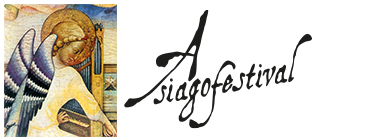August 09, 2007
Bastian and Bastienne, an opera by the 12-year-old Mozart
Among the woods of Asiago with the Breganze Youth Orchestra. Asiago, Prunno Location , August 24, 2007
ASIAGO
FESTIVAL 41st Edition
BASTIANO AND BASTIANA, OPERA DEL DODICENNE MOZART, AMONG THE WOODS OF ASIAGO WITH THE BREGANZE YOUTH ORCHESTRA
After the acclaimed concert by the very young pianist Leonora Armellini (Tuesday, Aug. 21 at the Church of San Rocco in Asiago), AsiagoFestival concludes its summer programming with Wolfgang Amadeus Mozart’s first opera, “Bastiano e Bastiana,” which will be staged on Friday, Aug. 24 (9 p.m.) in the Prunno, that is, in that natural amphitheater in the woods just a few kilometers from Asiago. A youth opera interpreted by the Breganze Youth Orchestra (conductor Martina Pettenon) and set precisely in the woods where Mozart had imagined the story of the two shepherd boys and their youthful love.
A tender love that sours because of a “He” lured by the flattery of the world. A “She”
who makes him jealous in order to win him back. And wins him back.
A story already known, you know, but if a bucolic atmosphere, a magician-shepherd and, above all, the brilliant music of a 12-year-old boy named Wolfgang Amadeus Mozart also intervene, even the world’s best-known story takes on colors and tones of great prestige.
And so with “Bastiano e Bastiana,” a singspiel in one act (libretto by Friedrich Wilhelm Weiskern, Johann Müller and Johann Andreas Schachtner, from the opéra-comique “Les Amours de Bastien et Bastienne”) Mozart revealed to Viennese society in 1768 his makings as a born liederist, giving the operina a candid stylistic fulfillment, a cordial, folksy tone that makes it vital even today, as soprano Jose Borgo (Bastiana), tenor Gianfranco Cerreto(Bastiano) and bass Alberto Spadarotto (magician Colas) will demonstrate in Asiago, who, under the direction of Davide Dolores, will bring this short, naive and serene score to life.
The gestation of this short play involved a small crowd of characters between Paris and Vienna in the mid-18th century. Originating as a parody of Rousseau’s famous “Devin du village” (1752) by the Guerville-Favart couple, it was imported to Vienna in 1764 by two actors, Weiskern and Müller, who prepared, on a commission from Count Durazzo, the German text that the 12-year-old Mozart used: not, however, before Johann Andreas Schachtner of Salzburg put the finishing touches to the libretto of the operina. Which, to further complicate the story, was perhaps performed in the house (or garden) of Anton Mesmer, the physician-scientist of magnetism mentioned in Così fan tutte : however, it is not possible to know for sure, since all documentation on the matter is lacking. In the definitive text, the theme of authentic, innocent pastoral life of Russovian memory, the latest fashion among theatrical subjects of the time, is combined with uncovered, mischievous references to the corruption and moral degradation into which love can incur if drawn into the orbit of money.
The ideal of natural simplicity , advocated by the Enlightenment in music, is assumed by the young Mozart in the ‘apparent immediacy of the sixteen numbers of this score. Melodies of enchanting sweetness and transparency follow one another, concealing an already remarkable maturity of writing, capable of masterfully combining art with nature; achieved at the age of twelve, without apparent effort, these results correspond to the aesthetic project of the mature Enlightenment, to which Mozart will hold fast until his last works. Among the most remarkable aspects of the score consider the original and pregnant melodic invention, the already remarkable thematic economy, the rhythmic vivacity and euphony in the orchestral writing (close to the youthful symphonies), the construction of perfectly chiaroscuro ‘miniature’ arias through the inclusion of a contrasting section. Overall, this Singspiel represents as much of the young composer’s originality as he was composing for the theater in those years, drawing – despite the apparent simplicity and immediacy of expression – on a degree of writing complexity that was already quite personal; there are vocal gestures of a buffo character worthy of the masterpieces of his maturity, such as the one that signals Bastienne’s outburst of pride when Colas dares to suppose that she too might be unfaithful (“Würd’ich auch wie manche Buhlerinnen”). To another place in Mozart’s maturity, to the Magic Flute , refers instead Bastien’s decision to kill himself if he cannot have Bastienne’s love: we seem to hear Papageno’s intentions, and in fact even here the suicide is only announced. The somewhat vacuous pacing of the inconstant Bastien is then described, while shortly afterwards the magician Colas displays his powers amid the esoteric formulas of a memorable aria (“Diggi, Daggi, schurry, murry”), set, in perfect Sturm und Drang fashion , in the somber atmosphere of C minor, and happily counterbalanced by the following piece, Bastien’s intense, serene minuet “Meiner Liebsten schöne Wangen,” thus creating a diptych underworld/helysian fields homologous to the Gluckian Orpheus and Eurydice.
ASIAGOFESTIVAL is organized by the Cultural Association “Friends of Music of Asiago” – “Fiorella Benetti Brazzale”, in collaboration with the Parish of St. Matthew, with the contribution and collaboration of the City of Asiago, Department of Tourism and Culture. Fundamental is the support offered by Banca Popolare di Vicenza, Burro delle Alpi – Alpilatte, Gran Moravia, Bassan Bernardo and Sons, and Rigoni di Asiago .
Friday, August 24 – 21.00 hours
ASIAGO – Prunno Location
“Bastiano e Bastiana” by W.A. Mozart Youth Orchestra of Breganze director: Martina Pettenon
soprano: Jose Borgo
tenor: Gianfranco Cerreto
bass: Alberto Spadarotto
director: Davide Dolores
– free admission -.
Press info: 335.8223010 (Marina Grasso)

